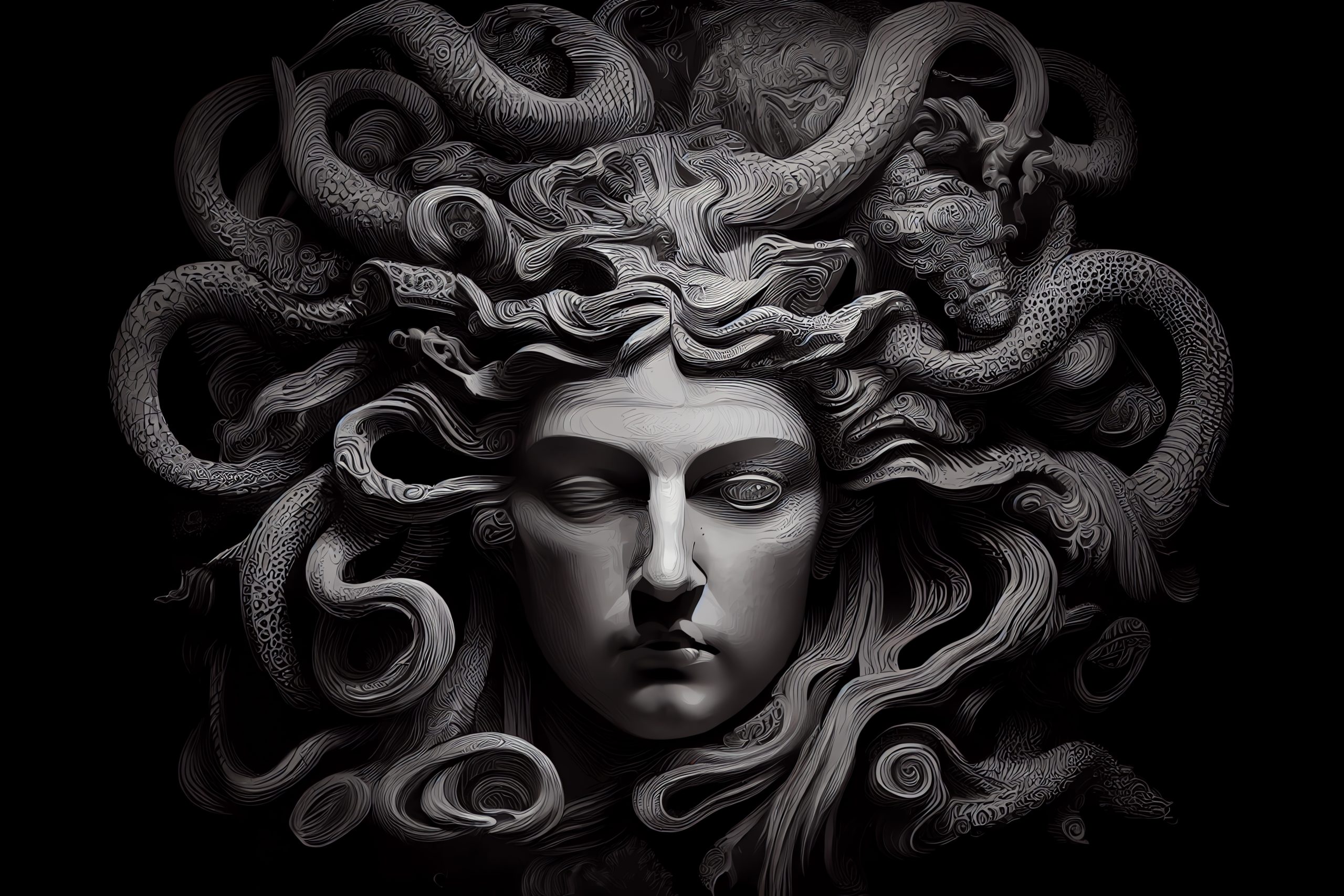
I met Medusa in Istanbul. I came eye to eye with her in the basilica cisterns and she didn’t turn me to stone, but she left a lasting impression nonetheless.
Istanbul is a majestic city housing some truly magnificent sites and buildings, but the most intriguing of places is the basilica cistern, a huge underground water collecting basin, right in the heart of the city, just across the street of the famous Hagia Sophia.
Visitors grow silent when they enter this subterranean abode, afraid to disrupt the apparent peace, as if to disrupt the peace would have potentially dire consequences. The place is eerily beautiful and oozes mystery. Carp fish swim happily and peacefully among the massive columns that rise above the water and the bottom glimmers with hundreds of coins, tossed in by people that are hoping for good luck and abundance.
The cistern has some peculiar features like the weeping column. The column gets its name from the carvings that resemble upside-down teardrops. The origin and the meaning of the column are not really known, but the carvings on the column evoke peacock feathers, which could symbolise royalty or could refer to the feathers of the phoenix. The building of the cistern was ordered by Byzantine emperor Justinian and his empress Theodora, along with the building of the Hagia Sophia basilica, and inaugurated the resurrection of the city of Constantinople in the aftermath of the Nika riots in 432 AD.
Another feature that stopped me in my tracks are the Medusa-heads that are located in a lower part of the cistern. The heads were originally completely submerged and the positioning of the heads is peculiar, to say the least: one is turned sideways and the other is turned upside down. As if the builders, or at least the people behind the building of the cistern, wanted to divert and defuse Medusa’s energy. The image struck me with sadness and nostalgia. I wondered what they were afraid of…
Who is Medusa and what is her story?
Like most myths, there are many different versions and Medusa takes on different shapes and meanings, depending on the writer or interpreter of the myth. Medusa was either one of the Gorgons and already a hideous creature at birth or a beautiful maiden that worshipped Athena. One day, as she was honouring Athena in one of her temples she either made love to, or was ravished by, Poseidon. Athena, outraged by the insult to her sanctuary, cursed Medusa and turned her into a hideous monster, very effectively preventing her from ever again having any contact with a man, with the added bonus of providing her with a gaze that would turn every man to stone.
One beautiful morning, Medusa, henceforth condemned to a lonely existence at the end of the earth, received the visit of the Greek hero Perseus who severed her head and offered it to the goddess Athena who promptly attached it to the Aegis, her shield or battle armour, as a trophy. When Perseus cut off Medusa’s head, 2 drops of blood were spilled on the earth and from these drops of blood were born the children of Medusa and Poseidon: Chrysaor, the giant with the golden dagger and Pegasus, the winged horse.
If we look at the Medusa myth as a metaphor, her story is a very interesting and revealing one.
No-one is sure where exactly the figure of Medusa came from and it would seem that she is a relic of pagan worship that was somehow transferred to Greek mythology. Medusa with her snake-hair reminds us of fertility goddesses, invoking the kundalini-energy that rises from the earth, weaves all energy-centres together, allows us to climb the internal ladder of divine knowledge and opens us up to our universal being. Images of Medusa-like goddesses can be found in matriarchal societies in Libya, where they represent the earth-mother, giving access to divine knowledge through a profound connection to the earth.
Medusa’s story is above all one of abuse. She didn’t last very long in the mythical Greek tradition, she was allowed to linger on a little longer, only to be abused, demonised and killed rather rapidly. Poseidon first abused her in Athena’s temple, Perseus killed her to obtain his goals and Athena used her power to magnify her own glory.
The word Medusa comes from the word Metis which means knowledge or divine knowledge. Metis, interestingly, is also the name of Athena’s mother, who was impregnated by Zeus and then swallowed by him because he was afraid that Metis (divine knowledge) would become stronger and gain more importance than him. His plan somewhat backfired when, by swallowing a pregnant Metis, he was forced to have his skull cleaved open a couple of months later, after a period of severe headaches, to give birth to Athena who sprung from his head in full battle armour.
Athena, who was born from the head of her god and father, or the mind and imagination of the masculine, kills her mother a second time by assisting Perseus in the beheading of Medusa (Metis).
Athena represents a new form of femininity, one that abandons all earth-connection and earth-wisdom, a feminine that is asexual (Athena was a virgin-goddess), that subscribes to male values such as justice with an iron fist and intellect over intuition and that seconds or supports the masculine, instead of owning her own place. She has the earth-goddess killed and thus the feminine is murdered twice: a first time by the male patriarch and then again by a masculinised feminine. With this act the goddess is banished from the earth and propelled into the heavens.
The message is clear: divine knowledge is not to be accessed by humans and any human who would try to access divine knowledge will be turned to stone and lose his life as a consequence.
The myth of Medusa is a creation myth. Medusa, earth, fertilised by Poseidon, water, gives birth to Chrysaor, the giant with the golden dagger who symbolises the sun or fire-energy and the power to make things grow (fertility); and Pegasus, the winged horse who symbolises the air element, he is a representation of poetry, beauty and magic, traditionally female values that have flown away from the earthly realm since the murder of the feminine, seeking refuge in our imagination. Pegasus protects sacred wells and fountains, indicating that inspiration can easily be found at these places that preserved their connection to the sacred feminine.
Since Athena, all things material and earthly have lost their divine spark. People stopped looking for the divine on earth, believing that all things earthly are evil, themselves included. They started seeing their earthly existence as a punishment, creating a world wherein spirit prevails and matter is neglected. Since the death of Medusa, we have been walking with our gaze directed towards the skies, ignoring what has been going on around us, unable to detect the divinity around us and unable to find our divine spark for it resides inside ourselves.
Unjustly so, Medusa herself has been turned into a symbol of female rage, while in fact she represents the suppressed feminine and the snake has become a symbol of forbidden knowledge and of forbidden sexuality. In reality, it’s not by looking at Medusa, but by ignoring her, that we were collectively turned to stone and forgot our humanity.
In this perspective, we can also translate the Greek Medusa myth to the biblical fall from grace, the gates to divinity were closed to us instantly from the moment we created the first imbalance. The rape of Medusa by Poseidon, symbolises the Flood in this instance, the drowning of a large part of the earth by water. This act of violence symbolises the submerging of Atlantis, the submerging of an evolved human consciousness and the following state of oblivion of the human race.
Medusa has, quite effectively, been turned upside down, along with the sacred feminine, female values and all of humanity. Women started acting like men, they started mimicking Athena in battle armour and started contributing to the suppression of female values. Women suppressed their sexuality, like the virgin goddess Athena and participated actively in the murder of the feminine. Medusa is above all a symbol of the perversion of female values and the creation of a major imbalance. Her death established a mind-oriented world vision that created a human race that carries the traces and suffers the consequences of centuries of neglect of part of its identity.
We are just starting to reclaim Medusa, we have started to resurrect the earth-goddess and give her back her rightful place here on earth. We are starting to truly understand the feminine and the dual nature of our reality and respect the earth and our natural environment. In doing so, little by little, we are collectively becoming whole again.


